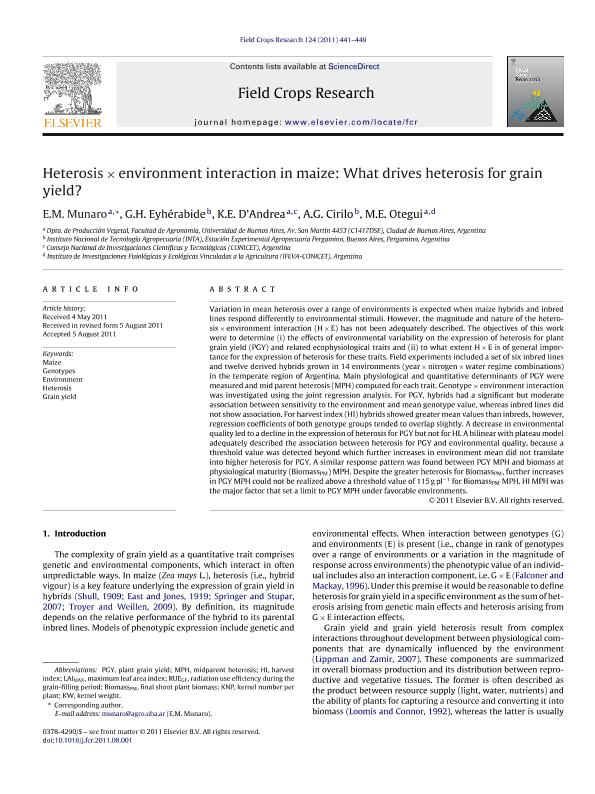Mostrar el registro sencillo del ítem
dc.contributor.author
Munaro, E. M.
dc.contributor.author
Eyherabide, G. H.
dc.contributor.author
D'andrea, Karina Elizabeth

dc.contributor.author
Cirilo, A. G.
dc.contributor.author
Otegui, Maria Elena

dc.date.available
2017-04-25T19:37:03Z
dc.date.issued
2011-12
dc.identifier.citation
Munaro, E. M.; Eyherabide, G. H.; D'andrea, Karina Elizabeth; Cirilo, A. G.; Otegui, Maria Elena; Heterosis × environment interaction in maize: What drives heterosis for grain
yield?; Elsevier; Field Crops Research; 124; 3; 12-2011; 441-449
dc.identifier.issn
0378-4290
dc.identifier.uri
http://hdl.handle.net/11336/15728
dc.description.abstract
Variation in mean heterosis in maize over a range of environments can be expected when hybrids and inbred lines respond differently to environmental stimuli however, the magnitude and nature of heterosis x environment (H x E) interaction has not been adequately described. The objectives of this work were (i) to determine the effects of environmental variability on the expression of grain yield and ecophysiological traits in a set of six inbred lines and their derived hybrids grown in 14 environments (year x nitrogen x water regime combinations) and (ii) to what extent H x E interactions are of general importance for the expression of heterosis for these traits. Field experiments were conducted at Pergamino, Argentina during 2002-2003, 2003-2004, 2004-2005, 2006-2007 and 2008-2009 growing seasons. The variability among experiments was manipulated by applying supplemental irrigation or dry land farming and two nitrogen levels. Main physiological and quantitative determinants of grain yield were measured and mid parent heterosis (MPH) computed for each trait. Genotype x environment interaction was investigated using the joint regression. For plant grain yield (PGY), hybrids had a significant but moderate association between environmental sensitivity and mean genotype value, whereas inbred lines did not show association. For HI hybrids showed greater mean values than inbred, however, regression coefficients of both genotype groups tended to overlap slightly. A decrease in environmental quality led to a decline in the expression of heterosis for PGY but not for HI. A bilinear model adequately described the association between heterosis for PGY and environmental quality and we identified the existence of a threshold value beyond which further increases in environmental quality did not translate into higher heterosis for PGY. A similar response pattern was found between PGY MPH and BiomassPM MPH. Despite the greater heterosis for BiomassPM, further increases in PGY MPH could not be realized above a threshold value of 115 g pl for BiomassPM MPH representative of high quality environments. HI MPH was the major factor that set a limit to PGY.
dc.format
application/pdf
dc.language.iso
eng
dc.publisher
Elsevier

dc.rights
info:eu-repo/semantics/openAccess
dc.rights.uri
https://creativecommons.org/licenses/by-nc-nd/2.5/ar/
dc.subject
Maize
dc.subject
Genotypes
dc.subject
Environment
dc.subject
Heterosis
dc.subject.classification
Agricultura

dc.subject.classification
Agricultura, Silvicultura y Pesca

dc.subject.classification
CIENCIAS AGRÍCOLAS

dc.title
Heterosis × environment interaction in maize: What drives heterosis for grain
yield?
dc.type
info:eu-repo/semantics/article
dc.type
info:ar-repo/semantics/artículo
dc.type
info:eu-repo/semantics/publishedVersion
dc.date.updated
2017-04-24T20:42:13Z
dc.journal.volume
124
dc.journal.number
3
dc.journal.pagination
441-449
dc.journal.pais
Países Bajos

dc.journal.ciudad
Amsterdam
dc.description.fil
Fil: Munaro, E. M.. Universidad de Buenos Aires. Facultad de Agronomía. Departamento de Producción Vegetal; Argentina
dc.description.fil
Fil: Eyherabide, G. H.. Instituto Nacional de Tecnología Agropecuaria. Centro Regional Buenos Aires Norte. Estación Experimental Agropecuaria Pergamino; Argentina
dc.description.fil
Fil: D'andrea, Karina Elizabeth. Universidad de Buenos Aires. Facultad de Agronomía. Departamento de Producción Vegetal. Cátedra de Cerealicultura; Argentina. Consejo Nacional de Investigaciones Científicas y Técnicas. Oficina de Coordinación Administrativa Parque Centenario; Argentina
dc.description.fil
Fil: Cirilo, A. G.. Instituto Nacional de Tecnología Agropecuaria. Centro Regional Buenos Aires Norte. Estación Experimental Agropecuaria Pergamino; Argentina
dc.description.fil
Fil: Otegui, Maria Elena. Universidad de Buenos Aires. Facultad de Agronomía. Departamento de Producción Vegetal; Argentina. Consejo Nacional de Investigaciones Científicas y Técnicas. Oficina de Coordinación Administrativa Parque Centenario. Instituto de Investigaciones Fisiológicas y Ecológicas Vinculadas a la Agricultura. Universidad de Buenos Aires. Facultad de Agronomía. Instituto de Investigaciones Fisiológicas y Ecológicas Vinculadas a la Agricultura; Argentina
dc.journal.title
Field Crops Research

dc.relation.alternativeid
info:eu-repo/semantics/altIdentifier/url/http://www.sciencedirect.com/science/article/pii/S0378429011002656
dc.relation.alternativeid
info:eu-repo/semantics/altIdentifier/doi/http://dx.doi.org/10.1016/j.fcr.2011.08.001
Archivos asociados
